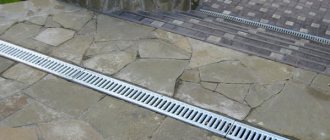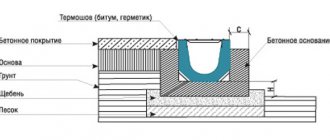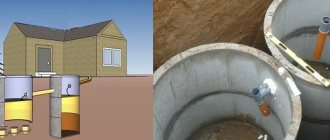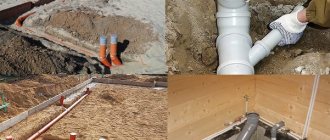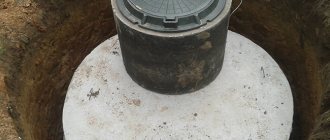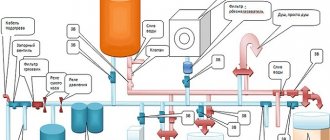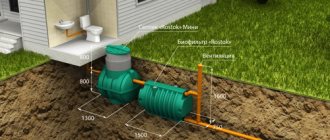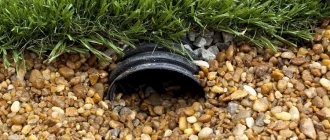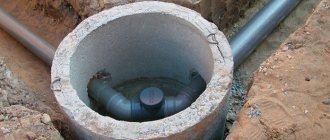Residents of multi-storey buildings most often do not pay attention to where the water goes after a rainstorm or during the melting of snow. But the problem of storm water drainage must be fully resolved by the owners of private houses.
We welcome our regular reader and offer him an article about what pipes are used for storm drainage.
We want to live in a clean, well-kept house, without puddles and puddles on the paths, streaks on the walls, stagnant liquid in the garden, on the surface of the beds and flower beds after a rainstorm. All these problems are solved by a drainage system consisting of surface water intakes and a pipeline system for discharging wastewater into the municipal sewer.
Why do we need a storm drain?
The main purpose of storm or rainwater drainage is to remove excess moisture from the area around the house.
Such a storm drain around the house consists of water pipes, filter elements and various devices, with the help of which, in addition to removing moisture, it is possible to perform the following functions:
- Organization of watering of plantings on a summer cottage or personal plot in order to have a positive effect of melt water on the growth of plants.
- Extending the service life of the main structure on the site, increasing the strength characteristics of the foundation. This is explained by the fact that an equipped moisture removal system prevents flooding of the foundation of the house, therefore reducing the risk of the formation of harmful fungi and mold.
- High-quality purification of melt and rainwater from small grains of sand and other impurities.
- Preservation of the proper appearance of tile sidewalks and asphalt surfaces, which are destructively affected by water flows from melting snow and heavy rainfall.
- Reduce the risk of basement or basement flooding.
- Prevents the formation of puddles and dirt on the site after precipitation.
What happens if you choose wrong?
The wrong choice of pipes for the storm and melt water drainage system is fraught with the following troubles:
- During heavy rainfall, wastewater will not have time to flow into the sewerage system and will accumulate on sidewalks, paths, green areas, roads, playgrounds, etc. Water will interfere with pedestrians and vehicles, and electric vehicles will have to be stopped altogether (due to safety requirements).
- Runoff can wash away lawns, flower beds, and vegetable gardens; in areas with a large slope it can seriously damage the top fertile layer and cause soil erosion.
- But the most unpleasant thing is if water from the roofs of buildings accumulates in the storm water inlet area and seeps into the soil near the foundation. This can cause the foundation and walls to become soaked, water seeping into the basement, and mold and mildew to develop.
What does a storm drain consist of?
The design of any system requires the presence of certain components; storm drainage around the house is no exception in this regard.
Well
A well in a storm drain can have a different volume; this parameter depends on the dimensions of the roof, the area of the site and the average amount of precipitation characteristic of a particular region.
To make a well, you can use concrete rings, and the lower ring must have a bottom. For the installation of modern storm sewers, plastic containers are used, which are characterized by complete tightness, unlike prefabricated concrete structures.
The plastic well is installed on a concrete pad, which is preliminarily installed at a certain depth. It is recommended to securely fix the plastic well to prevent the container from floating up during operation of the system.
Technical characteristics of pipes for rainwater drainage
Pipes that will be used to equip the stormwater system must comply with their operating conditions:
- strength - consumables must withstand various mechanical impacts, including compression, bending and shock;
- tolerance to ultraviolet rays - pipes installed on the surface of the site must withstand exposure to sunlight;
- resistance to aggressive reagents - sediments with various impurities will flow through the system;
- resistance to temperature changes - the consumable will remain in the same position all year round. Therefore, it is recommended to give preference to pipes that are resistant to winter and summer temperatures.
Hatch over the well
Any material can be used to make a hatch. This element of the storm drainage system can be rubber, plastic or metal. The choice is made by the owner, guided by personal preferences. When arranging the deck, it is necessary to take into account that the lid should be located 15-20 cm below ground level.
In most cases, the hatch is laid on a previously made brick neck, so you can plant flowers or sow lawn grass around the well. The plantings will hide the hatch, and the area will not stand out from the general background. You can purchase a ready-made cover with a hatch, but in this case the cover is located at a level of 4-5 cm below the ground surface, which makes the hatch more noticeable and draws attention to the inside of the well.
The hatch for the storm drain well at home is most often black, but you can find red and yellow options.
Foundation drainage: types and features
In difficult hydrogeological conditions of the area, the underground part of the building is protected using three types of drainage arrangement:
- wall-mounted – for houses with a basement and ground floor;
- ring - for houses with all rooms above ground level;
- stratal - for a slab foundation below the waterproof layer.
The wall drainage system is located underground along the wall.
The ring drainage is located 1.5-3 m away from the walls. At the bends, the pipe is rounded or has an inspection well. Typically the system is located around the entire circumference of the building, but there are exceptions.
The reservoir drainage surrounds the pipeline ring, and a layered drainage bedding is located under the slab.
Reservoir drainage is arranged even before the foundation is poured Source readmehouse.ru
Point storm water inlets
These storm drainage elements in a private house are small tanks installed in places where there is a large accumulation of water. This may be the lowest point of the site or a place under drainpipes. In most cases, point storm water inlets are made of concrete; they are used to construct deep-type storm drains. To achieve the desired height, the elements are stacked on top of each other. Recently, in specialized stores you can find plastic storm water inlets, which can also be built on (read: “How to choose and install rain water inlets for storm sewers - theory and practice”).
Combined or separate system
In a private house, storm drainage can be open, point and mixed. Each of them has its own purpose, and they differ in design.
Open sewer
This design is effective and easy to manufacture. The system is manufactured as a network of plastic, concrete or steel gutters placed on the soil surface. With their help, water from drainpipes enters a special container or general sewer system. The gutters must be covered on top with special decorative grilles to prevent debris from getting into them. The gutter parts are connected and treated with sealant. This type of storm drain is capable of collecting moisture from a very large area; water can be directed into it not only from the roof of a residential building, but also from various areas, sidewalks and garden paths.
Recommendation! When installing an open storm drain, do not forget about the slope of the installed gutters, otherwise the water will not drain well.
Point sewerage
When using point storm drainage in a private house, all pipelines must be placed below the ground surface. Water coming from the roofs flows into rainwater inlets protected by decorative gratings, and from them enters an underground pipeline. Along them, she goes to gathering places, or beyond the boundaries of the personal territory.
Recommendation! Underground communications are physically difficult to install in the soil; it is best to arrange it during the construction of a residential building. Once the garden area is built up, this work will become difficult to complete.
Mixed storm sewer
These systems are used when there is a desire to reduce labor and money costs. It can use elements of any storm drainage system.
Often different sewer systems are located on a site nearby or located in parallel, so there is a desire to save money and combine different systems. For example, connect all systems to an existing well. We must warn you that you shouldn’t do this; when there is heavy rain, a lot of water flows into the well - about 10 m2 per hour, and it will fill up very quickly, sometimes the water even begins to overflow. If the sewer from the house is connected to it, then the water will flow into the sewer pipes, as a result, your drains will not leave your plumbing fixtures. When the water level in the well drops, a lot of debris will remain inside, it will have to be cleaned, otherwise the sewage system from the house will not be able to work normally.
When rainwater enters the drainage well, everything will be even worse. During a rainstorm, rainwater enters the system, all the pipes will fill, and it will begin to flow under the foundation. The consequences will not please you; in addition, silting of the drainage will occur. It is impossible to clean this system, and replacing the pipes will require spending a lot of money.
There is only one conclusion - for storm drainage you must make your own capacious well.
Sand traps
These storm drainage elements collect grains of sand and other heavy particles. Most sand traps are made of plastic, so their cost is quite low. Despite this, performance characteristics remain high.
Sand traps must be located at the same distance from each other, which is determined by the parameters of the site. Regular cleaning of these storm sewer elements allows you to maintain the working condition of the entire drainage system.
Lattices
The presence of gratings in the water drainage system ensures maximum water removal from the soil surface on the site. The quality and performance characteristics of the gratings depend on the material of manufacture.
In particular, we are talking about the following options:
- Cast iron grates are reliable and durable. But when choosing these storm drainage elements, you should take into account that the paint on them does not last more than 3 years. Consequently, after this time, cast iron gratings become less attractive, which contributes to a decrease in the aesthetics of the entire structure.
- Steel gratings are considered the cheapest option, but are characterized by low quality. This is explained by the tendency of steel to form pockets of corrosion, therefore, after 2-3 years of operation, the gratings will become covered with rust.
- Grilles made of aluminum alloys are stronger and have an attractive appearance, but their cost is quite high.
Pipes
The most important element of storm or rainwater drainage can be called pipes. To equip the drainage system, red-colored polyethylene products are used. The inner surface of such pipes is smooth, so the throughput of the system is higher. If we consider cast iron or asbestos pipes, then using them can also ensure good drainage.
When choosing a pipe diameter, it is necessary to take into account the overall branching of the storm drain in the area and the amount of water collected. The best option involves laying pipes with a diameter of more than 15 cm.
Manufacturing materials
Today, storm drainage products are made from the following materials:
- Asbestos;
- Cast iron;
- Fiberglass;
- PVC;
- HDPE.
Asbestos pipes
They are used in the construction of centralized systems. However, today their use is declining. This material is not subject to corrosion and rotting, has low thermal conductivity, and does not require deep penetration into the ground during installation.
However, the products are too heavy and do not withstand strong point impacts, which often occur during repairs and maintenance of communications. In addition, there are certain difficulties in installing joints and connections. In European countries, asbestos cement is prohibited for use in residential construction, since studies have shown that this material is unsafe for human health.
Cast iron
This material is practically no longer used for organizing storm drains. Previously used for installation of external systems. It is distinguished by its high cost, heavy weight and not very smooth walls, which often cause blockages.
Fiberglass
Quite modern material. It is a combination of polymer and reinforcing fiberglass, which gives the product special strength. Typically, fiberglass products are used when installing collectors, centralized or simply large systems.
This material has a number of positive properties, namely:
- Even pipes with a large cross-sectional diameter (500 mm) have a relatively low weight;
- The material is considered environmentally friendly;
- Inert to chemicals;
- Strong and durable (service life of at least half a century);
- A large selection of shaped products simplifies installation. The connection is made using double-cone couplings with special seals that guarantee tightness.
PVC
The most common material for organizing storm drains. It is most often used when installing indoor and outdoor networks. Typically, products with a diameter of 110 or 160 mm are used. They are distinguished by high strength and reliability; they can be buried in the ground up to four, and in some cases up to ten meters. The inner surface is very smooth, which means it will not cause congestion. In addition, such pipes are easy to install, thanks to a wide range of shaped products and fittings. But the main advantage of PVC products is their low price.
True, there are several disadvantages:
- Such pipes are not designed for high pressure;
- They are usually short in length, up to three meters;
- High hardness.
Low-pressure polyethylene
Storm sewer pipes can be made of HDPE
, that is, low-density polyethylene. Such products are used for the installation of large systems with heavy loads. So, if the building is more than 10 meters in height, the use of PVC pipes is undesirable, since such systems are not designed for such loads. The pressure created can cause the sockets to disconnect. Polyethylene pipes can withstand loads of up to 25 atmospheres. They are mounted end to end using welding.
Inspection well
Such designs are recommended for installation on long-distance pipelines or with numerous branches. The main purpose of these storm drainage elements in a dacha is to provide the ability to clean pipes when a blockage occurs. In most cases, inspection wells are made of plastic or concrete.
When deciding how to make a storm drain or storm sewer, not all of the listed elements of the system may be used. However, their maximum quantity will ensure more efficient removal of excess moisture from the area around the house.
Average prices for turnkey plot drainage
Many companies offer professional services for installing drainage systems, but they are not that cheap. During the work, a double-wall pipe with a geotextile filter will be used.
The pipeline is connected to a plastic well
| Depth in centimeters | Price in rubles per linear meter |
| 100 | 2 500 |
| 150 | 3 200 |
| 200 | 4 200 |
| 250 | 6 900 |
The main stages of constructing a quality system
Open storm drain
The system is easy to install, which allows you to install storm drains yourself, without the involvement of professional craftsmen. The main elements of the open system are surface gutters. The water flows down the drainpipe and is discharged through gutters into special tanks or the general sewer system.
Surface gutters can be metal, plastic or concrete. It is recommended to cover these elements with special grilles on top to prevent the entry of large debris and make the appearance of the structure more attractive.
An open storm drain system can cover a large area, collecting water from sidewalks, garden paths and various areas.
Closed system
Installation of a closed or point-type storm drain involves the location of all water intakes underground. The system works on the following principle: water flows from the roof through drainpipes and enters a special rainwater inlet, which are connected to underground channels. Through these channels, water is discharged beyond the perimeter of the site.
Choosing a drainage well
For the most efficient collection and disposal of water, several types of systems are installed in the area around cottages and country houses. Most often, the arrangement of sewer, drainage and storm water disposal systems is carried out in parallel, at a short distance from each other.
Very often, owners of suburban areas want to save on installing storm drainage systems. In this case, they try to combine elements of different systems. An example of such an error is the use of a drainage or sewer well to drain water from a stormwater system. This option is called an error for the following reason: during heavy rainfall, water enters the well quickly and in fairly large volumes. You need to understand that the drainage system has its own specific purpose. This can cause the well to overflow, which, for example, in the case of a sewer, can lead to water leaking into the pipes of this system and into the plumbing. In addition, you should understand that a large amount of water brings various debris, which may well cause clogging of the stormwater system pipes after the water leaves. Therefore, you need to know how to properly make a storm drain.
If we consider the option of discharging the storm flow into the well of the drainage system, then in this case a large amount of water will lead to disruption of its performance and flooding of the foundation. An even bigger problem can be caused by silting of drainage pipes, which requires not cleaning, but a complete replacement of the drains.
From the above, we can conclude: when installing a storm sewer, you need to make a special well, and it must have the appropriate volume. As a last resort, you can drain water into any body of water, provided it is located nearby.
Groundwater drainage
Only a foundation drainage system, which is recommended to be installed before building a house, will help protect the foundation of the building and drain water.
Draining groundwater away from the house using a deep drainage system is more suitable for areas with high groundwater levels. It is designed by professional specialists according to the following plan:
- the soil of the area for placement is studied;
- the level of groundwater rise is determined for the period of rains and snowmelt;
- the estimated load on the drainage system is calculated, taking into account the water collection area;
- The slopes of the terrain are determined to perform gravity flow.
Deep drainage of groundwater is carried out using perforated drainage pipes. There is a valve in the well that prevents wastewater from flowing back into the drain.
Installation of a foundation drainage system Source stroimdom.com.ua
Project creation and preparatory work
The correct drawing of the future storm sewer and design diagram allows you to organize effective drainage on the site at minimal cost. Therefore, before you make a storm drain with your own hands, you need to draw up its design.
To draw up a project, certain calculations are required, which are based on the following data:
- The average amount of precipitation typical for a particular region.
- Frequency of precipitation.
- Snow depth.
- Drainage area.
- Roof area.
- Wastewater volume.
- Availability and location of underground communications.
- Soil properties at the site.
When deciding how to make a storm drain with your own hands, you need to calculate the volume of moisture that will be removed from the site, use the formula:
Q = q20*F*K.
Here Q denotes the required volume of moisture, q20 is the amount of precipitation, F is the area from which water will be drained, K is the correction factor, which is determined by the covering material of the area. For example, for an area covered with crushed stone, you need to take a coefficient of 0.4. An asphalt area requires the use of a coefficient of 0.95, for a roof - 1.
Based on the obtained values, the optimal pipe diameter is determined.
The depth of laying drains and trays when installing storm drains with your own hands is also determined by the local conditions. In most cases, pipes with a diameter of up to 50 cm are placed at a depth of 0.3 meters; a large diameter pipeline is recommended to be placed at a depth of 0.7 meters.
When choosing the depth of the pipeline, one point should be taken into account. If it is possible to insulate pipes and other elements of storm drainage, then you don’t have to deepen the system too much. In this case, some savings are obtained by reducing the cost of excavation work.
As for the required storm drain slope for a yard with a drain, these values are strictly regulated:
- Pipes with a diameter of 15 cm should be located with a slope of 8 mm per linear meter.
- Pipes with a diameter of 20 cm are laid with a slope of 7 mm per linear meter.
Which one is better and why?
The best pipe is a two-layer corrugated or fiberglass pipe. Durable (corrugation is also plastic). If you have an earthquake-prone area or there is a danger of landslides, you will have to lay a steel, cast iron, or fiberglass pipeline. But if you need to lay a pipeline to the collector at a depth of less than 2 meters and there are no particular difficulties in geology and load on the soil surface, then it is better to choose inexpensive HDPE or PVC pipes and not bother. They will last for 50 years. And maybe more.
Calculation of pipeline diameter
To calculate the diameter, you first need to calculate the amount of liquid drained using the formula:
Q=q20*F*φ, where
Q is the amount of water that the sewer system should remove when it rains;
q20 – intensity of precipitation for 20 minutes. This information is available from your local surveyor's office;
F – area of the plot or house. The area of the house is equal to the area of the horizontal projection of the house (taking into account the roof overhang). There is no need to calculate the area of the roof slopes;
φ – correction factor depending on the type of surface of the protected area. It depends inversely on the ability of the surface to absorb water. For asphalt – 0.95; for concrete – 0.85, for roofing – 1.0; for crushed stone – 0.4; for soil - 0.75, sand or gravel - 0.4.
The diameter is determined according to the Lukin tables. Knowing the water flow rate in l/s, you can determine the required pipe diameter. The ratio h/D (the height of the pipe filled with liquid to the internal diameter of the pipe) should be taken equal to 1. Tables and counters based on them are easily available on the Internet.
Approximate price (table)
In a standard urban area, pipes with an outer diameter of 110-160 mm are most often used. Prices for products of these diameters are shown in the table.
| Material | Diameter, mm, wall thickness, mm | Price 1 m |
| Steel | 108×4 | 550 |
| Steel | 159×4 | 810 |
| HDPE | 110×10 | 160 |
| HDPE | 160×14,6 | 330 |
| PVC | 110/4 | 190 |
| PVC | 160\4 | 320 |
| Double-layer corrugation | 110 | 130 |
| Double-layer corrugation | 160 | 200 |
Fiberglass pipes are produced with a diameter of 300 mm or more - they are not suitable for a private home.
Installation of roof drainage
It is necessary to make special holes in the roof covering and insert rainwater inlets into them. They are fixed with bitumen mastic and the joints are treated with sealant.
Next, sewer pipes and risers are installed, securing them with clamps to the facade of the building. For open storm drainage, trays are laid at the dacha; for point collection of water, drainage pipes are additionally installed.
Technical requirements
There are a number of requirements for external storm sewer pipes, namely:
- Strength - they must withstand soil pressure well;
- Heat resistance;
- Resistance to low temperatures for a long time;
- Resistant to moisture and a number of chemicals. Since the system is buried in the ground, it may be adversely affected by the active soil environment and wastewater;
- Smoothness of the internal walls to avoid the formation of accumulations and congestion;
- Considerable length. The fewer connections required, the more reliable the entire system will be.
Ground work
Work on arranging a storm drainage system for a country house involves preparing a trench for laying the pipeline and direct installation of the system.
The actions are performed in the following order:
- The trench must be dug taking into account all the nuances, including the drawn up layout diagram, the angle of inclination and the depth of laying the pipes.
- The bottom of the trench is carefully leveled and compacted.
- Then make a sand cushion about 20 cm high.
- A pit is being constructed to install a collector well.
- Pipes are laid on a sand cushion in a trench and connected to each other using fittings.
- If the pipeline branch is more than 10 meters long, then inspection wells are additionally installed, and sand traps are installed in places where storm water inlets meet the pipes.
- They inspect the finished structure, paying attention to the integrity of the system.
- At the next stage of solving the problem of how to make a storm drain on the site, they check the tightness and operability of the system. For this purpose, water is poured into the water intake.
- If there are no defects, the trench is filled with soil, and the gutters and trays are covered with gratings.
Installing a storm drain is not particularly difficult, so you can make a storm drain on your site yourself. Modern storm drainage allows you to extend the service life of the main structure on the site, maintain the attractiveness of sidewalks and paths, and eliminate the formation of dirt on lawns and other areas.
Definition and regulatory framework
Storm drainage, also known as rain drainage, also known as storm sewer, is a multicomponent engineering system designed to collect and drain precipitation and melt water. But if in most cases it is aimed specifically at getting rid of excess moisture, then in some situations it can also be used to obtain the missing one. When there are problems with water supply in the area, rainwater will be an excellent help. How much can actually be collected from a roof, depending on the area and level of precipitation, can be calculated exactly if desired, but there is also the result of “full-scale tests”.
GerasimForumHouse Member
My statistical patch: a roof of 100 m², a drain in four corners, one corner led into a four-cube font. A full font (from 25 m² of roof) is filled in a month. Not Moscow, but the north of the Moscow region.
And even if this water is technical and “along the way” it will pick up dust and debris, it is quite possible to use it for irrigation and other needs that do not require crystal transparency.
In a more familiar functionality, the storm drainage system of a house, together with the blind area, protects the foundation of the house and other buildings and prevents the formation of stagnant puddles. This is on sandy soils with a low groundwater level and a couple of hours after the rain there is nothing left anywhere. And on clay, and even with high water flow and in the summer, or even in the off-season, without the construction of a storm sewer there will be not a yard, but a swamp.
Although almost all existing standards are advisory in nature in relation to private sector objects, this is not a reason not to use them. Why reinvent another kind of wheel when everything has already been thought out and calculated, all that remains is to apply it. When calculating storm drainage for your country house, you need to focus on the current SP 32.13330.2018 Sewerage. External networks and structures. SNiP 2.04.03-85. At the moment, this is the latest updated edition, developed in another century and another state of rules. It applies to both those under construction and those already in operation and those being reconstructed.
